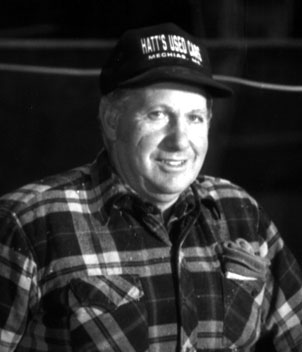In the News
Maine Coastal News
April 2012

BEALS ISLAND – One of the most noted designers and builders of the Maine lobster boat, Ernest Libby, Jr., known to his friends as Nernie, of Beals Island, passed away on the morning of 21 February.
Ernest was born 5 May 1935 on Beals Island to Ernest Libby Sr. and Alfreda (Beal) Libby. He started out like most builders, wandering through shops around the island when he was young, and intently watching the old-timers building their boats. He then began building small wooden outboard boats, 16 to 18 feet in length. When he was about 20 he went to work with his uncle, Clinton Beal, who taught him the ins and outs of wooden boat construction.
Clinton Beal worked for Riley Beal over on Oscar Carver's Point He worked there for quite a few years after he graduated from high school. “He started building boats on his own just awhile before I started for him in '57,” said Ernest. “Then I worked with him until '63 or '64. One year we built six, and two or three of the years we built five and we always took the summer off.”
He started by building wooden boats, “of course that is all there was anyway,” explained Ernest. “I built 30s, then 36s, outboards; anything I could get a chance to build. I think over the years I have built about 70 boats and have been involved with another 40 glass ones.”
One of the most noted boats to come out of Ernest 's shop was the Marguerite G. which almost anyone who has been associated with the lobster boat racing over the years, has heard. Ernest said, “There was really nothing special about her except that she was the fastest boat at the time. Of course we used to do a lot of racing when I was younger, but she was a break-through because the boat would plane and she didn't use any spray rails. Boats we had before that always used spray rails. The owner said use your own judgment and build it any way you want. So I built it the way I wanted to and it came out to be faster than any of the boats around at the time.”
There have been a lot of changes over the years in the way boats look. Ernest said, “They used to build a quite flat bottom boat. I never did build a real flat bottom boat. I consider that the real flat bottom boat throws more water. Now I use a semi-v for the stern, which is pretty close to being flat and a rocker keel so the bow will come up when you are sailing. She will also run on a following sea.”
Of course the easiest way to know if a boat is good or not is to use it and Ernest did just that by lobster fishing since he was a young boy. He said, “If I built a boat, I used it. If I wanted to change it, I did, where a lot of guys who fish; all they know is what people tell them.”
In the late-1970s, Ernest combined with the Young Brothers of Corea to design and build them several models that they would produce in fiberglass. The first boat he designed for them was their 33-footer. “When they built the first one,” said Ernest, “the old 38-footer, I talked with them a few times. Of course I've known those fellows since I was a kid. They used to be down here on the island with their grandparents. When they put that boat out, I knew they wanted more boats so I went to see them and I built the 33 first.”
Ernest then built them their 45-footer, which was followed by the 40, 30, 38, and finally the 36. Since completing the 36 footer, the Young Brothers have talked to Ernest about several other models including a 70-footer.
In 1989, Ernest designed and built his own 38 footer. The differences between this and the Young Brother's 38, designed by Libby, is that this one is a little wider and a little higher sided. There is also not as much flare in the bow. “The boat worked well,” said Ernest.
Over the years Libby has finished off quite a few fiberglass boats of his designs from the Young Brother's models and then of his own design, which included the 38, 34 and 41.
One very interesting design that Ernest has done is a 36-foot cruising sailboat. He said, “Well, I wanted to build it for myself, but I probably will never be able to. I'm hoping someone will come along.”
The history of the Beals Island-Jonesport style lobster boat goes back to quite away. At one time Ernest said that there was said to be 12 boat shops on Beals Island alone. Some say the model started with Will Frost, who built over in Jonesport. Libby said, “I knew Will Frost. I am not old enough to remember his building. I knew George Addington, that helped him build. They built the Red Wing and the Thorobred, which were the first torpedo stern boats.
“He owned the Thorobred,” said Ernest, “and Will Frost owned the Red Wing. They were both real sharpshooters. They used them fishing but they were nothing like the boats today. He didn't own it an awful long time. He always claimed that his boat was the fastest, which I don't know which one was. When they had low power it seemed like the Red Wing was the faster boat. When they put more power in them the Thorobred would out do her. They claimed that when they put a new horn timber in the Red Wing they put more turn in the stern and this made her sail up. With more power she would lift her bow up too high and dig. I remember her sailing with a six cylinder Dodge, she would go just as good as she did with a straight eight Buick.”
Ernest also owned the Thorobred when he was working for his uncle in the late 50s. “I wanted to go fishing and I didn't have time to build a boat,” explained Ernest. “I bought it just to fish around the bays. It wasn't any good, though, because it rolled too bad. It was too narrow; they were only 7 feet wide and 36 feet long. I think they originally used to use Kermuths, which were around 40 hp. When I got her she had a V-8 Ford, probably 160 or 180 horsepower and all it had in it was straight drive reduction. You could fish around shoal water, but it wouldn't swing good. They were built for racing. They used to use them to fish with and they got by with them but it would roll so bad it would toss the traps out of them. I only used it for a couple of years.”
When looking back to find who influenced Ernest, you have to say that Clinton Beal taught him how to build the boats, but as for designing them, he learned that on his own. Ernest added, “There are a lot of guys that will put it on a piece of paper and blue print it. I don't do it that way. If I am doing the design I will take a scale ruler and I know how high sided I want the boat and how wide I want it. I can put it on paper first, and sometimes I have, but I have done so many now that I just make up the wooden model and lay it on the paper. Then I take the moulds off the wood.”
Knowing the design of a boat and what makes it move good, it is just my own idea,” said Ernest. “It is like everyone else; they have got their own ideas. They just make their moulds from scratch. That is not really hard to do. If you have worked all your life in a boat shop you are going to know pretty near what you need to make for a stem, stern and keel, and you know pretty well what you want to put in for moulds. To make the boat up from scratch and make the moulds is really the best way to do it. If you build a wooden boat, put it in the water and look at it. If something don't look right, like say the sheer is too quick, or not enough sheer, you build another one and you change it. When you build a glass boat, it is there; you can change it but it is quite a job.”
“You can't get everything into a boat,” added Ernest. “To get an all-around boat, is do the best you can and that is all you can do. Sometimes it works out all right, some-times not.”
The evolution of the lobster boat has not stopped yet and Ernest said he sees more changes coming in the future. He said, “I can see boats being a lot wider and with more freeboard. I like the old type boats, not awful high sided and with a good amount of sheer and fairly lean. They don't prove out in it today because they use them for so many different things; dragging and offshore fishing. The old lean ones weren't big enough for anything other than lobster fishing.”
If you look around the harbors of New England, especially 'Downeast' Maine, you probably have seen an Ernst Libby, Jr. designed lobster boat. They are good looking boats that are capable of good speed and will bring you home in a good blow. There is one in almost every working harbor along the New England coast. Ernest was one of the nicest men you could ever meet, but his passing also means a huge loss to the lobster design and construction.
Ernest was also placed in the first class of the Maine Lobster Boat Racing Hall of Fame at the Maine Fishermen’s Forum on 3 March.
Ernest is survived by his wife of 58 years, Myrtle (Beal) Libby; sons, Norman Sr. and wife, Eunilah, Ivan and wife, Becky, Glenn and wife, Sylvia, and LeBaron Sr. and wife, Charlene; special son, Winfred Alley Jr.; grandchildren, Tara and husband, William Crowley, and their children, Kristian and Kaiden, Norman Libby Jr. and wife, Heather, and their children, Nicholas and Hannah, Candy and husband, Ian Alley, and their children, Brooke and Avery, Chad Libby and wife, Jessica, and their children, Devan and Chad Jr., Glenn E. Libby and Michele, and their children, Skyla and Garrett, Darci Libby and LeBaron Libby Jr.; brother, Clinton Libby and wife, Leona; sisters-in-law, Eleanor Libby, and Betsy and husband, Curtis Robinson Sr.; brothers-in-law, Calvin Beal Jr. and wife, Jeannine, Wayne Beal and wife, Donna, and Dean Beal and wife, Norma; aunt, Iona Woodward; many nieces, nephews and cousins. He was predeceased by his brother, Franklin Libby; sister, Senith Tarr; and also by his in-laws, Calvin Beal Sr. and wife, Musette.
He was laid to rest at Great Wass Cemetery on Beals Island.




